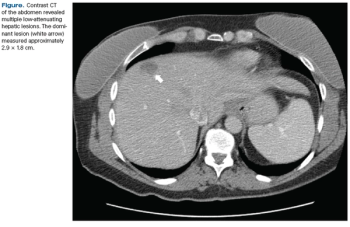
The attainment of “no evidence of disease” after treatment for metastatic breast cancer is significantly associated with prolonged survival, according to a new study.

Your AI-Trained Oncology Knowledge Connection!


The attainment of “no evidence of disease” after treatment for metastatic breast cancer is significantly associated with prolonged survival, according to a new study.

Multiple randomized trials and their meta-analysis have demonstrated an overall survival benefit from postmastectomy radiotherapy in women with node-positive breast cancer. However, none of the patients treated in these trials received neoadjuvant chemotherapy, which is now an increasingly common approach.

An asymptomatic 45-year-old woman presented for a screening mammogram and was noted to have a soft-tissue opacity with calcifications in the left breast. Ultrasound revealed a highly suspicious mass.

A study of women in Spain suggests that a Mediterranean diet accompanied by supplemental extra virgin olive oil is associated with a lower risk of breast cancer.

Current data challenge the statement that recommendations for postmastectomy radiotherapy should be based on the highest clinical or pathologic stage. Instead, data suggest that in a majority of patients, the pathologic stage after neoadjuvant chemotherapy carries more prognostic value.

Adding pertuzumab to first-line therapy for HER2-positive breast cancer has been shown to yield a survival benefit, but a new analysis says adding the drug is not cost effective.

Tracking tumor DNA in the blood of early breast cancer patients following surgery predicted relapse nearly 8 months earlier than conventional imaging.

A large study found that while the risk of dying from breast cancer after a DCIS diagnosis is quite low, it is on par with that of women diagnosed with small, invasive breast tumors, and that aggressive DCIS treatment does not produce better results.

The presence of the truncated form of human epidermal growth factor receptor 2 (p95HER2) in circulating tumor cells is associated with poor survival in breast cancer patients.

Both chemotherapy and anti-HER2 therapy can improve survival in HER2-positive breast cancer patients with brain metastases who undergo whole-brain radiotherapy.

Testing women for non-BRCA gene mutations that can confer breast or ovarian cancer risk has clinical management consequences for both the women and their family members.

Hypofractionated radiation therapy results in less toxicity and provides a better quality of life compared with conventional whole-breast irradiation, according to two recent studies.

A pair of studies suggest that aromatase inhibitors and bisphosphonates can each improve survival for postmenopausal women with early breast cancer.

Two trials reported marginal or no improvement in survival with nodal irradiation in early breast cancer patients, though reductions were seen in recurrence.

With the presentation and publication of the TEXT and SOFT trials in 2014, along with the aTTom and ATLAS trials in the last few years, deciding among the standard adjuvant endocrine therapy options for premenopausal women with hormone-sensitive breast cancer has become increasingly complicated.

For breast cancer specialists, much of the excitement at ASCO revolved around the emerging field of checkpoint inhibition in breast cancer and other tumors; however, there were four non-checkpoint presentations in breast cancer that also proved provocative.

Researchers have discovered that using progesterone in the treatment of breast cancer could result in better clinical outcomes.

Here, we provide an in-depth review of the current evidence for the addition of ovarian suppression to adjuvant endocrine therapy, and we offer recommendations for clinical management.

[18F]FDG-PET/CT could predict response in patients with metastatic HER2-positive breast cancer treated with lapatinib plus trastuzumab.

A new meta-analysis suggests that de-escalation of bone-targeted agents is a safe strategy in breast cancer patients with bone metastases.

As physicians, we strive to do no harm, and there is a narrow therapeutic window when treating elderly patients with cancer.

Utilization of breast-conserving therapy has increased over the years in early breast cancer but there are still barriers, including socioeconomic factors.

Neoadjuvant TDM-1 was shown to be effective in treating HER2-positive, HR-positive breast cancer compared with trastuzumab, with or without endocrine therapy.

Management of ductal carcinoma in situ (DCIS) commonly involves excision, radiotherapy, and hormonal therapy. Radiotherapy is employed for local control in breast conservation. Evidence is evolving for several radiotherapy techniques exist beyond standard whole-breast irradiation.

The addition of pertuzumab to trastuzumab and docetaxel offers significant improvement over other options in patients with HER2-positive breast cancer.